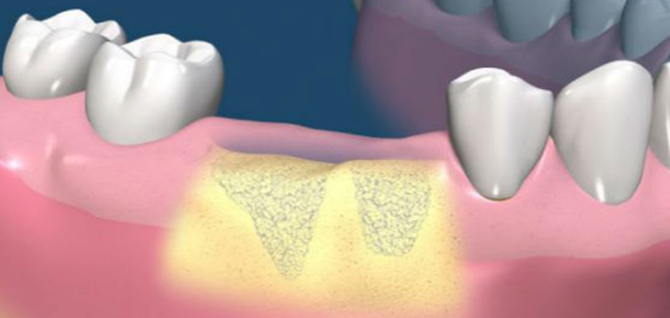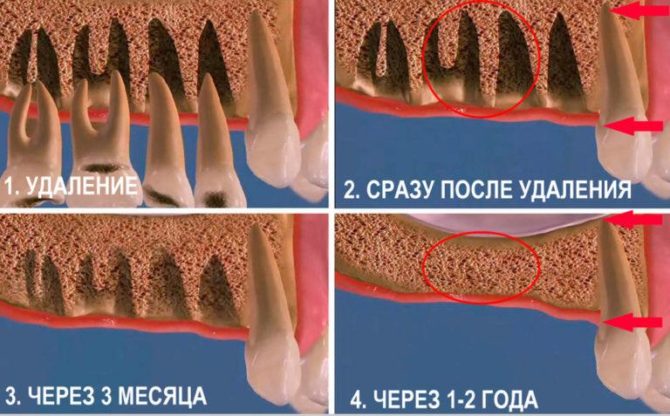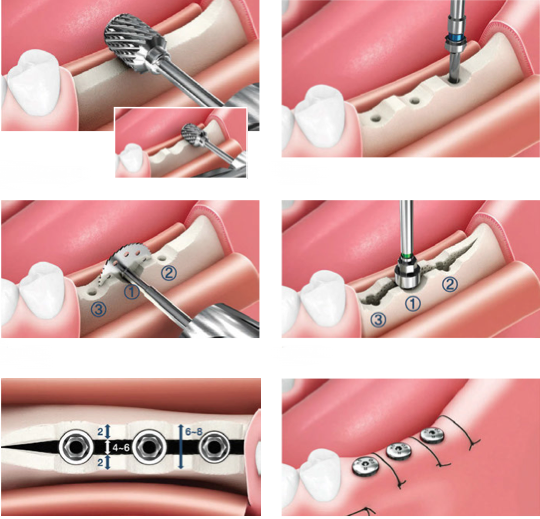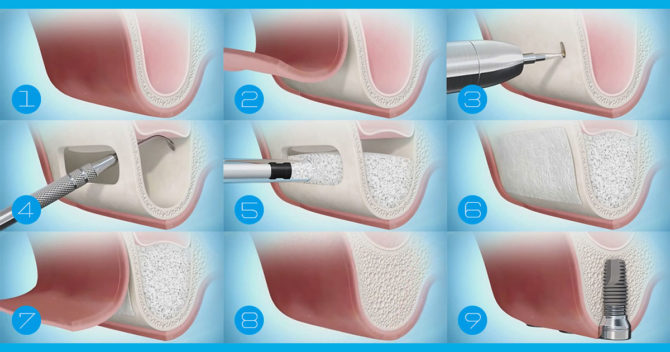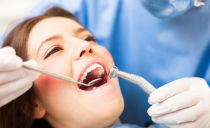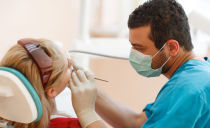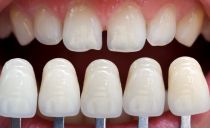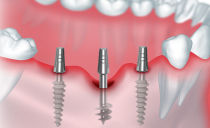Bone tissue extension before dental implantation: the essence of the procedure, methods, stages, cost
If a person has a tooth removed, changes in his jaw associated with the absence of a chewing unit begin. The area of the jaw where the removal operation was performed begins to decrease, because the bone in this place is degrading. Preparing for dental implants often involves building bone., without which the installed prosthesis will not be able to hold firmly in the jaw.
Content
The use of osteoplasty in dentistry
Osteoplasty is called artificial bone growth. The procedure is performed before dental implantation, if a long period has passed after tooth extraction, and the alveolar process has managed to atrophy. In this case, the patient may develop either horizontal bone resorption - a decrease in the width of the alveolar bone, or vertical resorption - a decrease in the height of the bone, or a combination of both forms of anomalies. If you do not build up the tissue, the cervical part of the prosthesis will appear through the thin and low bone wall surrounding the implant.
The jaw tissue must be increased with:
- The thickness of the vestibular (external) wall of the jaw bone is less than 2 mm - after implantation, the prosthesis will be exposed and spoil the smile line.
- The wall thickness between the prosthesis and the root of a healthy neighboring tooth or between two adjacent implants is less than 2–2.5 mm - after implantation, the interdental gingival papilla will degrade.
There are times when dentists inaccurately remove teeth and severely destroy the structure of the surrounding tissues. In such situations, plastic is also a mandatory indication for implantation.
Early bone growth can improve the result of implantation, restore the normal structure of the jaw, prevent tooth displacement, impaired facial expressions and chewing. This procedure can only be avoided in cases where the prosthesis is implanted almost immediately after tooth extraction or in the coming months after the procedure.
Methods of bone grafting during dental implantation
You can increase bone tissue using several technologies:
| Osteoplasty method | When applied | Features |
|---|---|---|
| Cleavage of the alveolar bone | To optimize the thickness of the alveolar bone in the case of developed horizontal resorption. | A relatively inexpensive method that does not require the use of expensive bone material. A very effective way of osteoplasty, as it provokes the natural processes of bone restoration. Implants are installed immediately or only 3-4 months after the procedure. |
| Bone block transplant | An increase in the width and height of the alveolar process. |
An effective method with a predictable result, but having a lot of disadvantages:
|
| Directed bone regeneration | An increase in the width and height of the alveolar process. | Simultaneous implant placement is possible. Insufficient survival rate was recorded due to tissue grafting from the outside, where there are few vessels. |
| Sinus lift | Building bone in height on the upper jaw - in its lateral part. | When building bone through sinus lift, simultaneous implantation is possible. With open sinus lift, implants are placed only after a few months. |
You can learn more about the methods for building the jaw tissue before implantation from the video:
The procedure for building the jaw bone under the dental implant
Bone tissue growth according to the methods described above is carried out under local anesthesia, which, at the request of the patient, can be supplemented by injection with a sedative. Anesthesia is necessary so that the patient does not feel discomfort when the gum, periosteum is cut and the bone material is manipulated. The procedure lasts 1-2 hours.
After installing the implantable material, the doctor must suture to protect the implanted tissue from possible infection and injury. Sutures are removed 10 days after plastic surgery.
Features of bone tissue extension methods
When the alveolar process is split, a gum section is made and a cut is made in the central part of the process. Then holes are made for installing implants into which the spreaders are screwed. Implants can be inserted immediately. Bone material is placed on the side of them, and a special membrane and sutures are applied on top.
When replanting a bone block, the portion of the implanted bone is taken from the patient himself (for example, from the maxillary cheek-alveolar ridge), from another patient with suitable parameters or from bulls, but the survival of donor materials is much lower. The bone block is screwed to the jaw with screws and covered with a collagen membrane, after which sutures are applied.
With directed bone regeneration, different types of bone material are suitable: artificial, own, bovine bone, a combination of one’s own bone with bovine, donor bones. Tissue material is seated from the outside, and the barrier membrane helps to form the jaw area and protect new cells from the effects of adverse factors.
Sinus lifting involves raising the bottom of the maxillary sinus. With the closed method of tissue growth, the doctor drills a hole between the jaw bone and the maxillary sinus and inserts a bone implant into it. With open sinus lift - makes a hole in the upper jaw, after which regeneration takes longer.
Features of the healing period of tissues
Bone healing is a complex process, during which as few negative factors as possible should affect the body. Therefore, during this period, bans may be imposed on:
- Flying in an airplane.
- Diving.
- Reception of hot or very cold, too hard food.
- Drinking drinks through a straw.
- Heavy physical exertion.
- A visit to the bath or sauna.
- Blowing your nose
After replanting bone tissue, catarrhal diseases are undesirable for implantation, therefore it is better not to carry out the procedure during epidemics.
The full list of rules that must be observed after building the jaw tissue, and the duration of compliance must be obtained from the dentist who performed the operation. The list of restrictions can be expanded if additional difficulties arise during the healing period.
Judging by the patient reviews, swelling, cyanosis around the area of build-up may occur during the first days after surgery. But after a while, in the absence of complications, the unpleasant symptoms disappear.
Contraindications to bone grafting in dentistry
Despite the need for bone growth for the normal functioning of the implant, some patients are denied this dental service. Contraindications to osteoplasty are:
- The abnormal anatomical form of the maxillary sinus.
- Operations in the past.
- Chronic rhinitis, sinusitis.
- The presence of polyps or malignant tumors in the neck and head.
- Tuberculosis.
- Clotting problems and other hematologic diseases.
- Endocrine and immune disorders.
- Poor anatomical condition of bone tissue.
Bone grafting of the lower and upper jaw is undesirable during pregnancy and lactation.
Smoking patients are recommended to give up the habit at least for a while, as nicotine provokes vasospasm, which reduces the rate of engraftment of the implanted tissue. You can’t smoke for several weeks before surgery for tissue extension and implantation and for 4 months after the procedures. If the extension and implantation is carried out with a time interval, the smoking ban is valid twice.
If any contraindications are found, the patient may be offered alternative prosthetics methods to reduce the risk of undesirable consequences. The first method involves implantation in deeper layers of the jaw tissue, not susceptible to atrophy. The second is carried out with non-removable prosthetics on the jaw, completely devoid of teeth - 4 or 6 implants are installed in it, on which a bridge with 12-14 crowns is fixed.
Complications after bone growth in dentistry
The appearance of complications after osteoplasty is possible due to several factors:
- Violations of the technique of performing an operation to build up, the mistakes of dentists.
- Inaccurate dentists during implantation.
- Low quality bone material used.
- Low quality used membranes.
These factors can cause unpleasant consequences:
- Exposure of the membrane from under the sutures, which causes purulent inflammation, requiring urgent treatment.
- The rejection of all planted bone material or some parts of it.
- Sinking used materials into the maxillary sinus - an operation is needed to remove them.
- Noticeable loss of bone material during engraftment, which may require reoperation.
- Injury of the implanted bone and periosteum during implant placement.
- The appearance of chronic runny nose.
How much does bone building for implantation cost?
An important issue for all patients is the price of dental bone building services. The following are estimated prices. How much the procedure will cost in a particular case depends on the clinic, the selected material, as well as the osteoplasty method.
| Osteoplasty Techniques | How much are |
|---|---|
| Bone extension for dental implantation by splitting the alveolar process. | The cost of the service is from 15 thousand rubles. in the jaw area for 1-2 teeth, materials - from 3 thousand p. |
| Bone block grafting, taking into account the collection of own bone material. | The cost of the service is from 36 thousand p., Taking materials for the operation - from 13 thousand p. |
| The growth of bone tissue in the upper or lower jaw by directed tissue regeneration. | The cost of the service on the jaw area for 1-3 teeth is from 25 thousand p., Materials - from 25 thousand p. |
| Osteoplasty of the upper jaw using sinus lift. | Closed sinus lifting - from 10 thousand p., Open - from 25 thousand p. excluding consumables. |
The growth of bone tissue in the area of the lower jaw is a necessary preliminary step before dental implantation for many patients. If the technology of plastic surgery is observed correctly, the presence of contraindications is checked, and the patient adheres to the rules of behavior during the rehabilitation period, such an operation helps to improve the condition of the dentition. To avoid problems that may occur with implants installed, you need to choose experienced specialists in the field of dental surgery.
To learn how to save on osteoplasty before implantation, watch the video:

